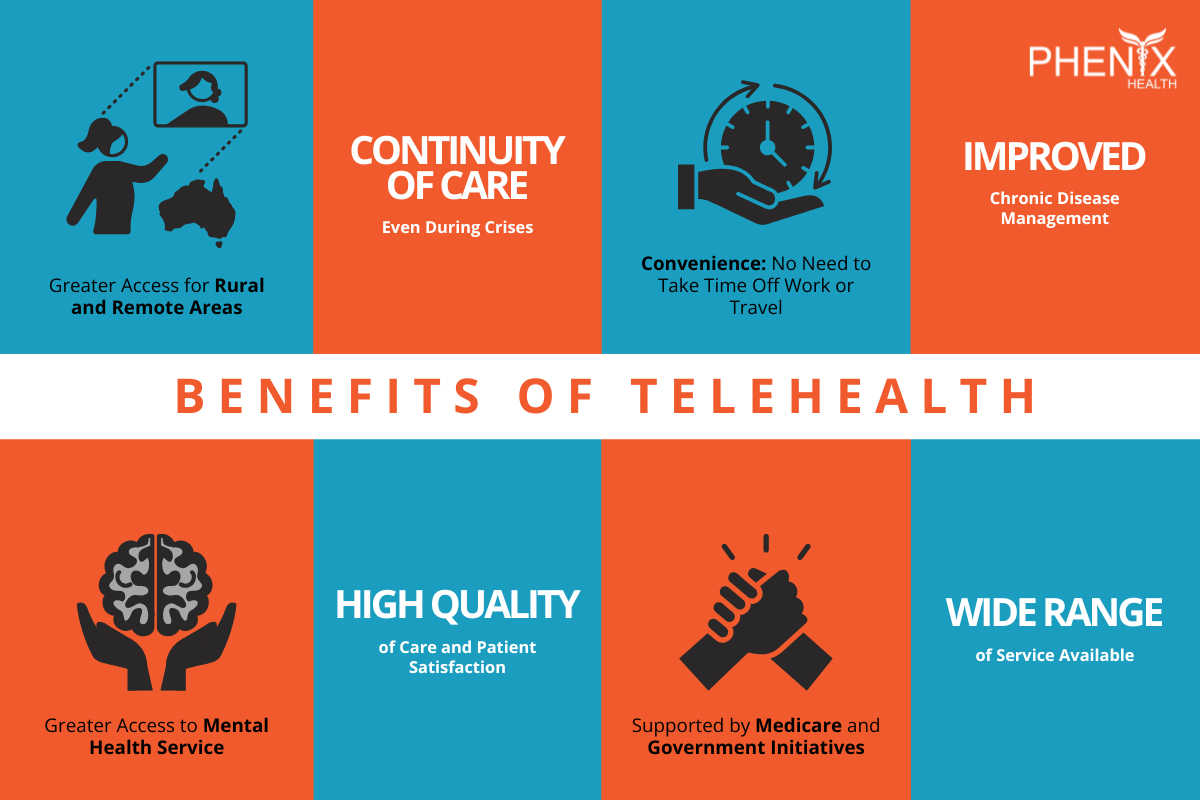The benefits of telehealth have made it one of the most transformative shifts in Australian healthcare in recent years. Once a niche concept, telehealth quickly became essential during the COVID-19 pandemic when the Australian government expanded access nationwide. This allowed patients to consult doctors via phone or video instead of attending in person. What started as a temporary measure has now fundamentally changed the way Australians access health services.
In fact, between March 2020 and mid-2022, over 118 million telehealth services were delivered to nearly 18 million patients. That’s a huge uptake of telehealth in a short time, and it’s easy to see why. Telehealth lets you talk to a healthcare provider (like a GP or specialist) from the comfort of home. Whether you use a phone call or a video chat, this digital health approach offers convenience without sacrificing quality.
Many Australians have found telehealth consultation so helpful that almost 90% said they would use it again if offered. In today’s post, we’ll count down some surprising benefits of telehealth and why more people are saying “yes” to online doctors in our healthcare system.
Benefits of Telehealth

1. Greater Access for Rural and Remote Areas
Australia is a big country, and access to healthcare services isn’t equal everywhere. If you live or travel in rural and remote areas, you often face long drives just to see a healthcare professional. Telehealth is changing that by bringing medical care to you. For patients in remote areas, this can be life-changing. For example, imagine the man running a farm hours from the nearest clinic – telehealth means he can consult a doctor via phone or video without leaving his property.
The Department of Health notes that telehealth improves access to timely care for Australians who would otherwise need to travel vast distances. This increased access isn’t only for GPs; specialists and allied health providers are also available via telehealth. One government report highlighted telehealth’s “critical role in ensuring the continuity of care” for patients across Australia.
By reducing the need to travel, telehealth makes sure that a patient in rural Queensland or the outback can get medical advice when they need it. It’s no wonder the uptake of telehealth has been enthusiastically embraced by patients and doctors alike in remote areas, it’s truly a telehealth service that brings the clinic to you.
2. Continuity of Care, Even During Crises
One of the most surprising benefits of telehealth is how it keeps healthcare going, even when life is disrupted. During the COVID-19 pandemic, telehealth became a lifeline that kept Australians connected to their doctors. The Australian Government Department of Health has stated that telehealth played a “critical role in ensuring the continuity of care” for hundreds of thousands of patients.
Even when lockdowns made face-to-face consultation impossible, people could still see their general practitioner or specialist by phone or video. This meant ongoing care for health conditions didn’t fall through the cracks. For instance, a study of mental health care found a 50% drop in in-person appointments during lockdowns, but telehealth stepped up to fill the gap; the use of telehealth for therapy sessions rose in equal proportion to the drop in face-to-face visits.
In other words, patients continued getting the help they needed thanks to telehealth. Beyond pandemics, telehealth also helps during floods, fires, or personal emergencies when you cannot travel. It ensures that your primary care is continuous and that your doctor can follow up on test information or adjust your treatment plan on schedule. This continuity of care keeps Australians healthier and more supported, no matter what challenges come our way.
3. Convenience: No Need to Take Time Off Work or Travel
Let’s face it, seeing a doctor the traditional way can be inconvenient. You might spend hours in transit or a waiting room, and you may need to skip work or other responsibilities. Telehealth changes that.
With a telehealth consultation, you can speak with a doctor from wherever you are, saving you travel time and money. This is especially valuable for busy people and parents. You might be thinking, “I am off work sick and need a medical certificate, can I just do it online?” With telehealth, yes, you can!
Doctors can provide guidance and documentation via telehealth without you having to leave home. Research in Australian general practice confirms the convenience factor: Telehealth offers increased convenience by reducing travel costs and work disruption. You don’t need to sit in traffic or arrange childcare just for a routine consultation.
Telehealth also tends to have shorter wait times, and you won’t risk sitting in a room full of other sick patients. Clinics report that when they offer telehealth, their patient “no-show” rates drop significantly. Fewer missed appointments mean you’re more likely to get timely care and not delay your health checks.
All these aspects of telehealth add up to a smoother healthcare experience. From the comfort of your couch or desk, you can handle many health needs on a lunch break. This convenience is a major reason more Australians are saying, “Just telehealth me instead of making me come in!” when appropriate.
4. Improved Chronic Disease Management
Managing a chronic condition (like diabetes, asthma, or heart disease) means regular check-ins with your healthcare team. Telehealth makes those follow-ups easier and more effective. Instead of postponing a review because you can’t get to the clinic, telehealth lets you have a quick appointment on your phone or computer.
This is a big plus for continuity of care in chronic disease management. Regular virtual check-ins help catch issues early and adjust treatments promptly. Telehealth can also support better monitoring, for example, you might share your blood pressure readings or blood sugar logs electronically with your GP.
According to experts, telehealth can also support more proactive engagement with patients who have chronic health conditions, keeping them on track with care plans. By making it easier to “see” your doctor or nurse, telehealth encourages patients to stick with their care routine rather than skip visits. It’s not just about convenience – it may improve your long-term health and well-being.
Early studies have noted the value of integrating telehealth into chronic care, such as better blood pressure control and fewer hospital visits for some patients. While every case is different, using telehealth as part of your chronic care means health practitioners can check on you more frequently.
Over time, that consistent support leads to better management of your condition. It’s like having a safety net of medical advice always within reach, which is a huge benefit for those who need ongoing care.
5. Greater Access to Mental Health Services
Seeking help for mental health can be daunting, and many Australians live far from psychologists or psychiatrists. Telehealth has opened new doors for mental health support. During the pandemic, Medicare began covering psychology and psychiatry sessions by telehealth, leading to a major shift to telehealth for counselling.
Many patients found it easier to attend therapy from home, and providers saw higher attendance rates. One review found that during COVID-19, there was a 50% reduction in face-to-face mental health consults but an equivalent rise in telehealth sessions to compensate, meaning people kept getting care when they needed it most.
Telehealth lowers barriers like travel, stigma (no sitting in a waiting room), and scheduling issues. For someone in a small town, a telehealth consultation with a mental health professional means they don’t have to drive hours to the nearest city psychologist. It also enables access to a wider choice of specialists across the country.
This is especially important for rural communities and those with limited local services. Telehealth mental health services include not just therapy calls, but also telepsychiatry for medication reviews, and even group support sessions run online. Australians have eagerly embraced this: services like Beyond Blue and others report high engagement via telehealth.
Telehealth’s implementation in Australia for mental health was so successful that many of these digital options remain in place today. By increasing access to healthcare for our minds as well as our bodies, telehealth is supporting better overall wellness. If you’ve been putting off counselling because of distance or time, telehealth might be the easy way to finally get support for your health and well-being.
6. High Quality of Care and Patient Satisfaction
Some people worry that not seeing a doctor in person might affect the quality of telehealth care. The good news is that telehealth has proven to be a high-quality way to deliver many healthcare services. For suitable issues (like follow-ups, medication refills, minor illnesses, mental health consults, etc.), patients report that telehealth feels just as thorough as an office visit. In surveys, patients and providers have both expressed high satisfaction with telehealth in general practice settings.
According to an Australian study, 87% of patients agreed they received the information they needed during a telehealth visit. Another national survey found 83% felt respected by their telehealth practitioner, and nearly 9 in 10 said they would use telehealth again.
These figures show the healthcare system has adapted well to virtual care. Doctors follow professional guidelines (like the Medical Board of Australia’s telehealth standards) to ensure care quality. Health professionals are trained to decide when an issue can be handled remotely and when an in-person exam is necessary.
In fact, the Royal Australian College of GPs published a guide to providing telephone and video consultations in general practice to help maintain high standards. Telehealth consultations are typically private and unrushed, and some patients find it easier to open up about sensitive issues when they’re in a familiar environment.
Of course, not every medical scenario is appropriate for telehealth; you might still need a physical exam or tests that require a clinic visit, but for many aspects of telemedicine, the standards are on par with clinic care. The bottom line: telehealth delivers quality telehealth care that Australians trust, which is why its popularity endures.
7. Supported by Medicare and Government Initiatives
Telehealth in Australia isn’t a temporary trend – it’s now a core part of the health system, backed by Medicare and government policy. Early in 2020, the government added hundreds of temporary telehealth items to the Medicare benefits schedule to subsidise telehealth appointments.
Seeing its success, they made telehealth an ongoing part of Medicare from 2022 onward. This means that for many general practice and specialist consultations, Medicare (or your private health insurance) covers the cost just like an in-person visit. Changes to telehealth policy have ensured that Australians everywhere can access these services.
The Department of Health and Aged Care worked with medical experts to design permanent telehealth services that continue delivering benefits beyond the pandemic. Today, eligible patients across Australia can consult GPs, nurses, midwives, and allied health professionals via telehealth if clinically appropriate.
By incorporating telehealth into the fabric of primary healthcare, the government has improved access to healthcare for millions. There are also safeguards: The Medical Board of Australia and AHPRA have guidelines to ensure telehealth is used responsibly and safely as a healthcare delivery method.
This strong official support gives patients confidence that “online doctors” are legitimate and regulated. In practical terms, it also means you might not have out-of-pocket costs – many telehealth GP services are bulk-billed (fully covered by Medicare benefits).
With government backing, telehealth has transitioned from an emergency measure to a primary health option for routine care. Australia’s health and aged care sector is truly embracing the future of medicine with these digital services.
8. Wide Range of Services Available
You might think telehealth is only for GP chats or getting a quick medical certificate, but it’s much broader. A whole range of healthcare professionals now provide services online.
According to the Australian Institute of Health and Welfare and the Department of Health, telehealth services in Australia are delivered by GPs, specialists, health practitioners like physiotherapists or dietitians, mental health professionals, and even some dentists.
That’s right, you can even start addressing the benefits of dental health through telehealth. For example, some dentists offer initial telehealth consultations for advice on tooth or gum issues. They can triage the problem and let you know if it’s something you can manage at home or if you need to come in for an urgent procedure.
This kind of tele-dentistry provides valuable information and peace of mind, especially if you live far from dental clinics. Similarly, allied health providers (physios, occupational therapists, nutritionists, etc.) use telehealth to conduct sessions, prescribe exercises, and guide patients remotely.
These services are provided through secure video platforms to ensure privacy. Telehealth implementation in Australia has shown that many services in Australia can be augmented digitally without losing effectiveness.
For instance, follow-up consultations after surgery, routine general practice check-ins, chronic care plan reviews, and even some mental health services can all be done online. This means you have a one-stop healthcare option that can cover a lot of your needs.
The aspects of telehealth that seemed futuristic a decade ago – like a “virtual clinic” – are now a reality. From GP advice to specialist opinions to providing telehealth services in aged care homes, online care is improving access across the board. With so many options available via telehealth, Australians can get comprehensive care without the hassle, and that’s a benefit we can all smile about.
Embracing the Future of Care with Telehealth
Telehealth has proven to be more than just a convenient alternative, it’s a powerful way to enhance our healthcare system. The shift to telehealth during COVID-19 taught patients and doctors alike just how effective virtual care can be.
Now, with its transition to telehealth as a permanent fixture, Australia is reaping the rewards: easier access for remote communities, uninterrupted care during crises, saved time and money, and high-quality interactions between patients and providers.
By embracing telehealth, we’re building a more flexible and resilient health system that puts patient needs first. If you haven’t tried telehealth yet, consider exploring its benefits for yourself.
Phenix Health, Australia’s trusted online doctor service, has been at the forefront of providing telehealth services to patients since 2013. With experienced GPs and a user-friendly platform, Phenix Health makes it easy to get the care you need without delay.
Why not give it a go and experience these surprising benefits firsthand? Your health matters, and with telehealth, accessing care is as simple as picking up your phone.
Book an online appointment with Phenix Health today and take charge of your health in a smart, convenient way!






Phenix Health delivers online health services 24/7 provided by Australian doctors and healthcare professionals.